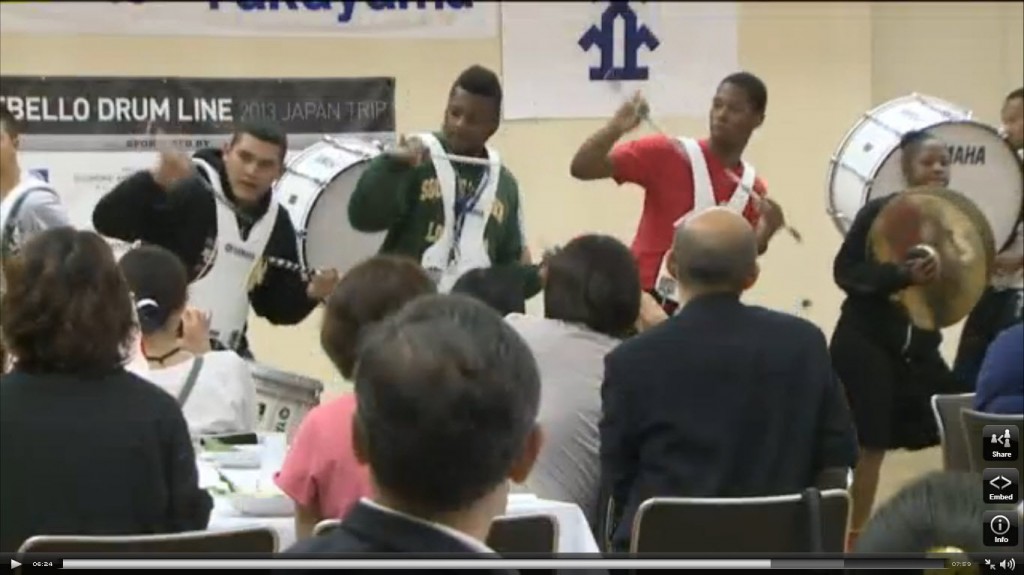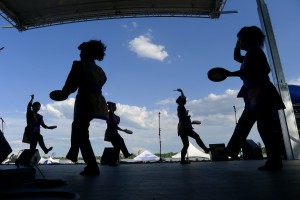July 15, 2013
Montbello High School Drum Line to perform during CDBF 2013 Opening Ceremony
 It was at Denver Mayor Michael B. Hancock's suggestion that the nine members of the Montbello High School Drum Line got the chance of a lifetime -- to take the second historic flight of the Boeing 787 Dreamliner on United Airline's new direct flight between Denver and Tokyo.
The students raised money for the trip with the help of sponsors, and they performed their synchronized drumming at the U.S. Ambassador's home in Tokyo, and several times in Takayama, Denver's sister city. The news report below is a sample of a half-hour special that airs this Friday, July 19 at 9:30 on KDVR Fox31. These students were cultural ambassadors for Colorado in Japan.
So the Colorado Dragon Boat Festival is proud to introduce the Montbello High School Drum Line as one of the highlights of this year's Opening Ceremony.
The Opening Ceremony, which begins at 10 am on Saturday, July 27, also includes a spiritual Eye-Dotting Ceremony with chanting Buddhist monks to awaken the spirit of the dragon boats; a dynamic Dragon Dance; and an Olympics-style Team Parade. The Drum Line will get the chance to perform in front of Mayor Hancock, who will speak during the ceremony.
It was at Denver Mayor Michael B. Hancock's suggestion that the nine members of the Montbello High School Drum Line got the chance of a lifetime -- to take the second historic flight of the Boeing 787 Dreamliner on United Airline's new direct flight between Denver and Tokyo.
The students raised money for the trip with the help of sponsors, and they performed their synchronized drumming at the U.S. Ambassador's home in Tokyo, and several times in Takayama, Denver's sister city. The news report below is a sample of a half-hour special that airs this Friday, July 19 at 9:30 on KDVR Fox31. These students were cultural ambassadors for Colorado in Japan.
So the Colorado Dragon Boat Festival is proud to introduce the Montbello High School Drum Line as one of the highlights of this year's Opening Ceremony.
The Opening Ceremony, which begins at 10 am on Saturday, July 27, also includes a spiritual Eye-Dotting Ceremony with chanting Buddhist monks to awaken the spirit of the dragon boats; a dynamic Dragon Dance; and an Olympics-style Team Parade. The Drum Line will get the chance to perform in front of Mayor Hancock, who will speak during the ceremony.





 I was born in Japan, so I can say this with a straight face: I'm becoming a born-again Japanese, and it's kinda fun.
For years now, Erin and I have thought of ourselves as Asian American first, and Japanese American second. Mostly, it's because we're interested in and feel a kinship with other Asian Americans, whether their heritage is Chinese, Vietnamese, Korean, Thai, Hmong, Indian, Filipino, whatever. We certainly have immersed ourselves in the local Asian American Pacific Islander community, through being involved in events such as the
I was born in Japan, so I can say this with a straight face: I'm becoming a born-again Japanese, and it's kinda fun.
For years now, Erin and I have thought of ourselves as Asian American first, and Japanese American second. Mostly, it's because we're interested in and feel a kinship with other Asian Americans, whether their heritage is Chinese, Vietnamese, Korean, Thai, Hmong, Indian, Filipino, whatever. We certainly have immersed ourselves in the local Asian American Pacific Islander community, through being involved in events such as the  It's May. Happy
It's May. Happy 